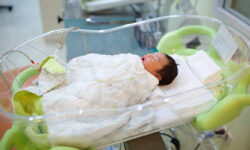Yes, it is possible for a child to be diagnosed with Cerebral Palsy even if the child’s MRI appears normal. An MRI will show medical professionals the structure of the child’s brain, but cannot always predict how well the brain is working.
The information in this post was compiled from government, educational non-profit, and medical expert sources.
Keep reading to learn about how an MRI can be used to diagnose Cerebral Palsy.
MRIs Reveal the Structure of the Brain
Magnetic Resonance Imagining (MRI) is a scan that medical professionals can use to observe the structure of the brain.
An MRI machine creates a powerful magnetic field. This magnetic field forces the protons in the patient’s body to align to the magnetic field. Surges of radio waves are then pulsed through the patient, knocking the protons out of alignment with the magnetic field.
Powerful sensors capture how long it takes the protons to realign to the magnetic field after each pulse. The sensors also capture how much energy the protons release as they realign.
Using the information captured by the sensors, computer software compiles layers of images of the body’s tissues. The software then arranges these layers into a 3D model. Using a DICOM viewer, medical professionals can explore this 3D model layer by layer to look for abnormalities in the brain.
Abnormalities in the Brain Can Be Evidence of a Brain Injury
Diagnosing injuries within the brain is challenging. Part of why diagnosing a brain injury is tough is because the brain is delicate and difficult to examine while a patient is alive. And, as much as medical knowledge has progressed in recent years, the brain can still be mysterious and difficult to fully comprehend.
One strategy that we have found productive for learning about and understanding brain injuries is to compare images of the brains of patients we suspect might have a brain injury to the images of brains from many other patients whom we believe to have healthy brains.
Suppose for example that MRI data reveals that every patient who complains about a certain symptom also has the same abnormality visible in their brain. In other words, everyone experiencing that symptom has a structural feature in their brain that differs in the same way from the brains that we believe are healthy.
Over time and with lots of testing, we may conclude that something about that abnormality is related to the symptoms those patients are experiencing.
In general, this comparison process is how much of our knowledge about the brain and brain injuries progresses. We compare the brains that appear to be healthy with the ones that we think may be injured, and we look for patterns that help us better understand and diagnose injuries within the brain.
Can an MRI Help Diagnose Cerebral Palsy?
Yes, an MRI can help medical professionals diagnose Cerebral Palsy.
Cerebral Palsy is often believed to be caused by injuries to the brain at or near childbirth. Oxygen deprivation, known as birth asphyxia or hypoxic-ischemic encephalopathy (HIE), is thought to cause brain damage that results in Cerebral Palsy.
Oxygen deprivation often leaves evidence of brain damage in the form of hypoxic-ischemic lesions. These lesions can be observed on the imaging produced by an MRI.
If an MRI reveals that a child has lesions caused by oxygen deprivation or HIE, the likeliness that the child has Cerebral Palsy increases.
However, it’s important not to overstate the role of an MRI in diagnosing Cerebral Palsy.
While MRIs provide helpful data for medical professionals to consider, an MRI cannot necessarily prove or disprove whether someone has Cerebral Palsy.
In one study on the topic, as many as 29% of patients (36 of 213 patients) with Cerebral Palsy showed normal brain structures in their MRIs.
This is because while an MRI reveals the structure of the brain, the imagery alone cannot necessarily predict how well a brain will function.
In summary:
An MRI can help medical professionals detect evidence of brain injuries that can cause Cerebral Palsy. However, it is possible to have a completely normal MRI and to still have Cerebral Palsy.
With this in mind, medical professionals often rely on a more comprehensive approach to diagnosing Cerebral Palsy. Other tools that medical professionals may use include: CT scans, EEGs, reflex tests, and a battery of observation based and developmental screenings.
To help people understand more about how Cerebral Palsy is diagnosed, we wrote a page dedicated to explaining an overview of the Cerebral Palsy screening and diagnosis process.
Getting help for a child with HIE or Cerebral Palsy
can make a big difference
Because early intervention is often key to helping improve a child’s wellbeing, it’s important to act swiftly. At the Brown Trial Firm, our Houston birth injury attorneys can help you investigate your case, find answers to your questions, and determine whether you are entitled to compensation. We offer case reviews at no cost or obligation. Many birth injuries that cause cerebral palsy could have been prevented.
Contact a Cerebral Palsy and Birth Injury Attorney
Getting help for a child with a birth injury can make a big difference. Early intervention and early treatment is often key to helping improve a child’s wellbeing. You must act quickly.
If you have questions about whether your child’s birth injury was caused by a preventable medical error, then our attorneys at Brown Trial Firm may be able to help.
Sources:
Benini R, e. (2020). Normal imaging in patients with cerebral palsy: what does it tell us? – PubMed – NCBI . Ncbi.nlm.nih.gov. Retrieved 18 February 2020, from https://www.ncbi.nlm.nih.gov/pubmed/22944004
Magnetic Resonance Imaging (MRI). (2020). Nibib.nih.gov. Retrieved 18 February 2020, from https://www.nibib.nih.gov/science-education/science-topics/magnetic-resonance-imaging-mri
Cabaj, A., Bekiesińska-Figatowska, M., & Mądzik, J. (2012). Zmiany niedotlenieniowo-niedokrwienne w badaniu MR ośrodkowego układu nerwowego u noworodków donoszonych i urodzonych przedwcześnie – obrazy typowe i rzadziej spotykane. Polish Journal Of Radiology, 77(3), 71-76. doi:10.12659/pjr.883379


